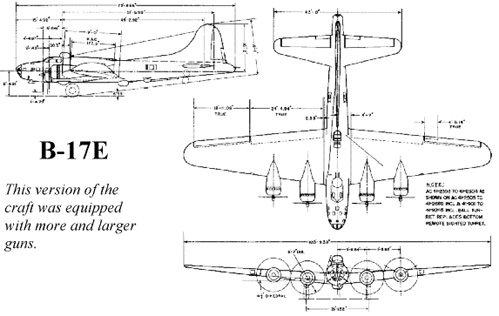Unfortunately, it was not the offensively configured B-17E model that went into combat first but rather the defensive B-17C. With the advent of Lend-Lease the Army sent 20 of their 38 C models to England as soon as they were available. The British renamed them the Fortress.USAAF and Boeing officials carefully emphasized that the Fortress I was designed to be flown in formation to make use of the total group's fire-power for mutual protection and that a number of practice bombing runs were needed before flight crews could make effective strikes. The American representative left with the belief that they had secured from the British assurances that the B-17C would not be used in combat but to train flight crews in preparation for the arrival of the B-17E.
The British took delivery of the first B-17Cs in the early summer of '41 and immediately threw them into battle, ignoring the experts. This was to a certain extent understandable given the situation at the time. Unfortunately these early missions were flown by single bombers or in twos or threes, never in a full formation. Bombing was done by crews with little training using the inferior Spary bombsight instead of the Norden. The results were predictable. Crews reported poor bombing results, when they returned at all. The British commanders were left with a poor opinion of the plane and a conviction that daylight, precision bombing was not a viable strategy. Still, these missions, however ineffectual should not be dismissed. The British experience provided Boeing with the information needed to make modifications to the on-going designs of the B-17E. When reports came back from England of equipment failure or deficiencies Boeing test crews would attempt to re-create them and then the engineers would correct the problem. These ranged from frozen guns and oxygen systems to intercom problems.
One problem repeatedly reported during the first few missions was jammed bomb bay doors. Once the plane was back at base the doors would cycle through normally. The Boeing teams could not repeat the problem even after a number of tests. This began to alarm the Boeing staff until the word came back that the cause had been discovered. As the planes climbed to altitude before entering enemy air space some of the flight crews would relieve themselves in the bomb bay where there was a slight gap at the door junction. In the extreme cold of high altitude their urine froze, jamming the doors. Once the plane dropped altitude as they neared their home base, the fluid would melt freeing the doors. The problem was quickly corrected.
As the B-17E began to arrive, the Fortress I force was reassigned as a trainer and a few craft were transferred to combat operations in North Africa.

More B-17 Flying Fortress
-
B-17: Introduction
B-17: The 299: Triumph and Disaster
B-17: Y1B-17
B-17: The Fortress I
B-17: The Pacific
B-17: Europe
B-17: Gotterdammerung
Back to Cry Havoc #16 Table of Contents
Back to Cry Havoc List of Issues
Back to MagWeb Master Magazine List
© Copyright 1996 by David W. Tschanz.
This article appears in MagWeb (Magazine Web) on the Internet World Wide Web. Other military history articles and gaming articles are available at http://www.magweb.com